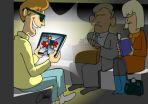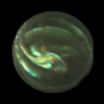(Press-News.org) Researchers have pushed the boundaries of High Dynamic Range (HDR) video to match our own eyes' ability to cope with the real world's ever rapidly changing light intensity - such as sun simply going behind clouds. Now researchers at WMG at the University of Warwick, have found a way to compress and stream HDR video directly to monitors and mobile devices, such as an iPad, bringing enormous benefits to industries including gaming and security.
Researchers at WMG at the University of Warwick, working in partnership with spinout company goHDR Ltd, have succeeded in achieving and patenting a method of real-time encoding and remote display of High Dynamic Range (HDR) video. Working with their Portuguese partner INESC Tec, they have also been able to demonstrate the technique in action on an iPad. This means that full HDR video content can now be encoded and streamed directly to remote displays, including mobile devices, or sent for storage back at home-base. Gaming will be transformed too, with HDR content being directly available for interactive online and cloud-based games.
HDR imagery delivers the wide range of light intensity levels found in real scenes ranging from direct sunlight to details of dark shade. HDR video thus offers "True Brightness"; a significantly enhanced viewing experience. The amount of data required to capture all this extra detail, however, is huge, with high definition True Brightness footage generating the equivalent of a CD worth of data every second. goHDR has a patented algorithm that is capable of compressing HDR frames by at least 150:1 with minimal perceptual loss of quality. The partners have now developed a new method that enables uncompressed HDR frames to be encoded and streamed to a remote device in real-time. Encoding rates of over 60 frames per second (fps) have been achieved for 720p resolution on a modern 16-core computer.
Professor Alan Chalmers, Professor of Visualisation at WMG, University of Warwick and Founder and Innovation Director of goHDR, said:
"This project has brought together worldwide expertise in HDR imaging from the University of Warwick and INESC Tec with the innovation and patented HDR video compression technology of goHDR. Together the partners have clearly demonstrated the technical feasibility of encoding and streaming HDR video content to mobile devices in real-time."
"Previously HDR video compression had to be done off-line. This meant the HDR video data from a camera had to be first stored on special high-speed disks, encoded and finally transmitted. This could take many minutes, precluding any live broadcasts. Real-time encoding now opens up many more opportunities for people to experience HDR content directly. For example:
In games, it allows full HDR game content to be delivered, even to a player of interactive games, from the cloud. Most video games are generated in HDR but until now, a data transmission bottleneck has prevented this extra realism from being delivered to the user.
In security, it enables surveillance cameras to deliver live HDR feeds, immediately providing all the details within a scene, even in extreme lighting conditions
In leisure, it allows streaming HDR content from a consumer camera, for example when snowboarding down a mountain, to your friends watching on their tablets back at home.
Professor Chalmers added: "Our work opens up the real-time delivery of HDR video to a wide range of devices. We expect in the future it will even be possible, with real-time encoding, to capture and stream HDR video from mobile devices."
Dr Maximino Bessa, lead researcher of the project at INESC Tec said: "Mobile devices are rapidly becoming the main means for viewing content and playing games. Delivering HDR video to a tablet brings about a step change in viewing experience for mobile devices."
INFORMATION:
For more information please contact:
Professor Alan Chalmers, WMG, University of Warwick
Innovation Director, goHDR Ltd.
Tel: +44 (0)2476 522102
Email: Alan.Chalmers@gohdr.com
Peter Dunn, email: p.j.dunn@warwick.ac.uk
Head of Communications, Communications Office, University of Warwick,
Tel: +44(0)24 76 523708 Mobile/Cell +44(0)7767 655860
Dr Maximino Bessa
INESC Tec, Portugal
Tel: +351 (0) 259350324
Email: maxbessa@utad.pt
Notes for Editors:
goHDR provides advanced data compression algorithms to customers developing HDR technology. The encoding/decoding software developed by goHDR enables the adoption of HDR video across many sectors, including film and television, computer games, security and mobile devices.
INESC TEC is the name of the Associate Laboratory coordinated by INESC Porto, a private non-profit association with over 25 years of experience in R&D and technology transfer. INESC TEC incorporates 12 Units with complementary competences, always looking to the international market. At INESC TEC, the knowledge and results generated as part of fundamental research are typically applied in technology transfer projects, always guaranteeing added and immediate social relevance. With the recent launching of INESC P&D BRASIL (in São Paulo, Brazil), INESC TEC has strengthened its presence worldwide, always associating Portugal to international scientific excellence.
PR210 29th November 2012
Maths helps mobiles & tablets match eyes' ability to switch from sunshine to shadow
2012-11-29
ELSE PRESS RELEASES FROM THIS DATE:
First-ever hyperspectral images of Earth's auroras
2012-11-29
WASHINGTON, Nov. 29—Hoping to expand our understanding of auroras and other fleeting atmospheric events, a team of space-weather researchers designed and built NORUSCA II, a new camera with unprecedented capabilities that can simultaneously image multiple spectral bands, in essence different wavelengths or colors, of light. The camera was tested at the Kjell Henriksen Observatory (KHO) in Svalbard, Norway, where it produced the first-ever hyperspectral images of auroras—commonly referred to as "the Northern (or Southern) Lights"—and may already have revealed a previously ...
Bacteria hijack host cell process, create their own food supply to become infectious
2012-11-29
COLUMBUS, Ohio – Bacteria that cause the tick-borne disease anaplasmosis in humans create their own food supply by hijacking a process in host cells that normally should help kill the pathogenic bugs, scientists have found.
This bacterium, Anaplasma phagocytophilum (Ap), secretes a protein that can start this process. The protein binds with another protein produced by white blood cells, and that connection creates compartments that siphon host-cell nutrients to feed the bacteria, enabling their growth inside the white blood cells.
The finding defies conventional wisdom ...
Insects beware: The sea anemone is coming
2012-11-29
Bethesda, MD—As insects evolve to become resistant to insecticides, the need to develop new ways to control pests grows. A team of scientists from Leuven, Belgium have discovered that the sea anemone's venom harbors several toxins that promise to become a new generation of insecticides that are environmentally friendly and avoid resistance by the insects. Since these toxins disable ion channels that mediate pain and inflammation, they could also spur drug development aimed at pain, cardiac disorders, epilepsy and seizure disorders, and immunological diseases such as multiple ...
Brain inflammation likely key initiator to prion and Parkinson's disease
2012-11-29
Prion diseases represent a family of neurodegenerative disorders associated with the loss of brain cells and caused by proteins called prions (derived from 'protein' and 'infection'). The diseases are found in both humans and animals, such as Creutzfeld-Jakob disease and mad cow disease respectively. Although mostly harmless, prions can transform into infectious agents, which accumulate in the brain and destroy the nervous tissue.
But how exactly does the accumulation of prions cause destruction of the brain? "Understanding the process by which prions destroy neurons ...
New genetic test detects early breast cancer and identifies future risk
2012-11-29
Bethesda, MD—Physicians may now be better at detecting breast cancer than ever before, but much more work remains to ensure accurate diagnosis is possible and especially to assess future risk. That's why researchers from Germany have been working to develop a new test of gene action to predict cancer risk both at first diagnosis and into the future. In a new research report appearing in the December 2012 issue of The FASEB Journal, researchers show that the various genetic switches, which are turned on and off in the regular development of every cell in the body, can be ...
New approach allows past data to be used to improve future climate projections
2012-11-29
Climate scientists are still grappling with one of the main questions of modern times: how high will global temperatures rise if the atmospheric concentration of carbon dioxide doubles. Many researchers are turning to the past because it holds clues to how nature reacted to climate change before the anthropogenic impact. The divergent results of this research, however, have made it difficult to make precise predictions about the impact of increased carbon dioxide on future warming. An international team of scientists have evaluated previously published estimates and assigned ...
'Dark core' may not be so dark after all
2012-11-29
ATHENS, Ohio (Nov. 29, 2012)—Astronomers were puzzled earlier this year when NASA's Hubble Space Telescope spotted an overabundance of dark matter in the heart of the merging galaxy cluster Abell 520. This observation was surprising because dark matter and galaxies should be anchored together, even during a collision between galaxy clusters.
Astronomers have abundant evidence that an as-yet-unidentified form of matter is responsible for 90 percent of the gravity within galaxies and clusters of galaxies. Because it is detected via its gravity and not its light, they call ...
The future looks bright: ONR, marines eye solar energy
2012-11-29
ARLINGTON, Va. —The Office of Naval Research (ONR) is looking to the sun for energy in an effort to help Marines do away with diesel-guzzling generators now used in combat outposts, officials announced Nov. 29.
The Renewable Sustainable Expeditionary Power (RSEP) program seeks to create a transportable renewable hybrid system that can provide Marines with electricity for a 15-day mission without relying on fuel resupply convoys that often become targets for adversaries.
"This program takes on a number of power-related challenges and ultimately will allow the Marine ...
Mild vibrations may provide some of the same benefits to obese people as exercise
2012-11-29
Bethesda, MD—If you're looking to get some of the benefits of exercise without doing the work, here's some good news. A new research report published online in The FASEB Journal shows that low-intensity vibrations led to improvements in the immune function of obese mice. If the same effect can be found in people, this could have clinical benefits for obese people suffering from a wide range of immune problems related to obesity.
"This study demonstrates that mechanical signals can help restore an immune system compromised by obesity," said Clinton Rubin, Ph.D., study ...
Oceanic crust breakthrough: Solving a magma mystery
2012-11-29
Washington, D.C. — Oceanic crust covers two-thirds of the Earth's solid surface, but scientists still don't entirely understand the process by which it is made. Analysis of more than 600 samples of oceanic crust by a team including Carnegie's Frances Jenner reveals a systemic pattern that alters long-held beliefs about how this process works, explaining a crucial step in understanding Earth's geological deep processes. Their work is published in Nature on November 29.
Magmas generated by melting of the Earth's mantle rise up below the oceanic crust and erupt on the Earth's ...


